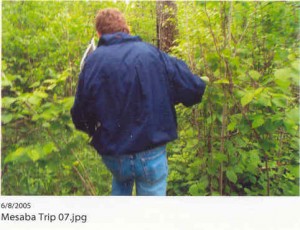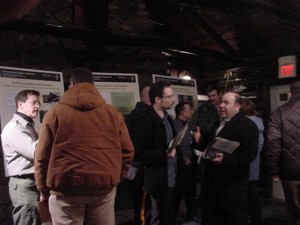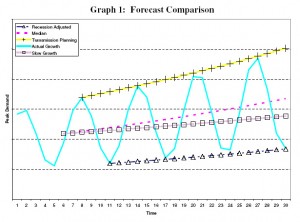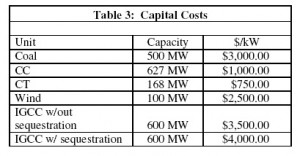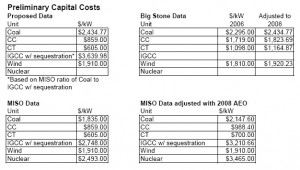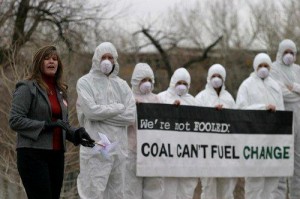The IGCC pipedream continues to fizzle
June 16th, 2010
A little birdie has been looking around at Mesaba — but first…
Here’s a report of an obvious problem with IGCC from John Blair, Valley Watch— the pipedream is just that, and the truth that those of us in the midst of coal gasification know too well is finally coming out publicly:
Carbon capture plans failing – IEA
“Much greater effort will be needed to meet future deployment levels,” it said.
Meanwhile, the little birdie… We’ve been in this odd and unenviable place, a big horrible coal gasification plant, the Mesaba Project, promoted by Excelsior Energy, a shell corp with nada for assets, which demanded a Power Purchase Agreement then denied by the PUC, and yet inexplicably granted a siting permit for not just “one” but TWO projects totalling over 1,000MW of IGCC! OH… MY… DOG! So it’s in limbo land, and we’re wondering how on earth this thing stays on life support as it rots away…
The little birdie had this report:
Excelsior Energy was supposed to have filed a new air permit, and the MPCA was supposed to have reviewed the 2006 air permit application “to assure that the protocol was acceptable to federal land managers.” Well, that didn’t happen, the “review” by MPCA OR the filing of the new air permit, which was supposed to have been filed last week.
… and the little birdie while looking around found this in their “Frequently Asked Questions” on their site, then scroll down to “View common transmission misconceptions” to p. 2:
Myth: The Mesaba Project will force wind energy off from the transmission grid.
Hmmmmmmmmm…
And this “Myth” section is a lot like their letter to Commerce regarding EIS Scoping Comments:
Anyway, I’d like to see this blog posting they’re referring to! Misinterpreted? Naaaaaaah, it’s all the interpretations of those presenting and reviewing at the MAPP meeting. Their claims are sorta like the matter of using a site with existing infrastructure:
I wonder what it was that blew their dress up… could it be:
So now it’s deliverable??? SWAG! January 9th, 2007
They caaalll Mesaaaba liiiars… November 25th, 2006
It’s all about this study — READ IT FOR YOURSELF:
Anyway, their air permit application was submitted, and it is a mess. The rules have changed. We’re waiting for the next Air Permit application, which will be… when???
NPS scoping hearings in progress
February 18th, 2010
Scene from yesterday’s NPS meeting at Camp Jefferson, Lake Hopatcong, NJ
PSEG’s Susquehanna-Roseland transmission line through the Delaware Water Gap is under scrutiny.
Just out – PSEG year end info (just searched SEC and don’t see it there yet):
And for some reason, I get that old hook line, a little perverted, i.e., “We gotta lock down our electric revenue, and then we’ll take it higher!”:
Yesterday was the second of three public comment hearings that the National Park Service is holding regarding PSEG’s application to expand the Right of Way and run its Susquehanna-Roseland through the Delaware Water Gap, a premier federally designated “wild and scenic” area. The good news is that people are really turning out, the first meeting, in Bushkill, PA, was about 100, and this meeting was twice that, standing room only in the log hall of Camp Jefferson.
Here is the NPS’ take on framework and issues for the Environmental Impact Statement:
Here’s a few snippets that I really find interesting — and of course want to expand on:
Air Quality
Construction and maintenance activities would impact air quality.Viewsheds
The new transmission lines and associated roadways would affect the visual viewshed. Viewshed impacts would be permanent. A separate viewshed analysis should be done for scenic and visual impacts. A comprehensive list of the viewsheds at DEWA does not exist at this time. However, the APPA is considered a scenic viewshed. The baseline conditions are represented by the current viewshed, which has not yet been evaluated.Climate Change/Greenhouse Gases
How the project contributes to the production of greenhouse gases and climate change, as well as how climate change would impact the project and park resources must be addressed in the EIS.Viewshed Appreciation
The new transmission lines and associated roadways could adversely affect the visitors’ appreciation of the visual viewshed. These impacts would be permanent. A separate viewshed analysis should be done for scenic and visual impacts for visitor experience.
The one that jumps out to me is “air quality.” I note that under “Climate Change/Greenhouse Gases” they acknowledge the project contribution of greenhouse gas and climate change, and that also needs to be added to the Air Quality section, the project contribution of pollutants to air quality.
Why? Check the RTEP, PJM’s 2007 RTEP that this Susquehanna-Roseland project was based on:
Critical RTEP Issues and Upgrades
PJM continues to address a number of issues with
a bearing on reliability in Pennsylvania and the
regional transmission expansion plans required to
maintain it:• Increasing power transfers through Pennsylvania to feed eastern Mid-Atlantic PJM load centers including those in Pennsylvania are expected to cause overloads beginning in 2016 on key circuits in Pennsylvania. New high voltage backbone facilities are required to mitigate these reliability issues. The new backbone facilities will also be assessed for their ability to support deliveries from a cluster of new coal-fired generating facilities currently proposed for central and northeastern Pennsylvania. Three major new backbone transmission facilities have been approved by the PJM to resolve growing reliability criteria violations in eastern Mid-Atlantic PJM and west/central Pennsylvania, upgrades that are now part of PJM’s RTEP:
• Susquehanna – Lackawanna – Jefferson – Roseland 500 kV circuit
• Amos – Bedington – Kemptown (PATH) 765 & 500 kV circuit
• Mid-Atlantic Power Pathway (MAPP): Possum Point – Calvert Cliffs – Indian River – Salem 500 kV Circuit
2007 RTEP, p.259-260 (emphasis added)
Beginning on p. 262, the RTEP lists 2,712 (check my math) of coal in queue. Yup, Susquehanna-Roseland could handle that! Here’s the full PA chapter of the 2007 RTEP — see for yourself:
The New Jersey one says essentially the same thing:
Those new coal plants and the impacts of facilitating/enabling those new coal plants and the impact on the Class I park must be addressed. The operational impacts, contributions to greenhouse gases, applies equally to air quality. This was an issue with Voyageurs National Park in the Mesaba Project review, and it should be here.
Here’s the “study area” designated by National Park Service – the “no data” spot is Picatinny Arsenal. What happens if you build transmission over an arsenal? What is the impact on the park if Picatinny Arsenal goes BOOM!?!?!
Here are some articles, thanks to Scott Olson ( Fired up and ready to go one more time! ) for compilation:
- Last stand: Critics slam power line plans across Delaware Water Gap, Appalachian Trail (Daily Record)
- Crowd of 200 puts Park Service on notice (New Jersey Herald)
- N.J. residents, environmentalists urge National Park Service to reject proposed $750M power line (Star-Ledger)
- New Jersey residents make plea to National Park Service to oppose power lines project (The Express-Times)
PolyMet Draft EIS released
October 28th, 2009
WOW… and here I thought PolyMet’s Draft EIS was as moribund as the EIS for Excelsior Energy’s Mesaba Project. Nope, here it is:
It’s HUGE, it will take a while, there are a lot of parts.
They are not accepting comments until after November 2, so after that time, I’ll post info on that.
Minnesota Resource Assessment Survey
October 21st, 2009
From the Minnesota Office of Energy Security:
… the Minnesota Resource Assessment … sigh…
Get out your waders… from the solicited Comments at the end, from “stakeholders,” (did I miss some notice and comment period here??? Did any of YOU get notice???) the problems raised are nearly universally complaints.
OK, now open it up and look … and in it on page 6 is that MOE’S napkin calulation that they finagled into the CapX 2020 record after we got extracted some damning testimony about decreased demand, this is such utter bullshit, look at this and see for yourself:
And you may ask, what that in the X axis? Good question, there’s no identification. And the Y? Same.
WTF?
This is the report we’ve been waiting so long for?
This is the report that, at the Legislative Energy Commission I testified at, Chair Solon-Prettner was asking for, demanding, because it was way late?
This report was presented in all seriousness to the Legislative Energy Commission? I would hope that I could hear them laughing all the way down here in Red Wing…
Here’s “Capital Costs” from page 19:
And further back, the Preliminary Capital Costs:
Oh, please… Commerce was part of the Mesaba Project, and Elion Amit did the economic analysis. From that 2005 data, this is way way off, THERE IS NO EXCUSE FOR THIS WHATSOEVER.
IGCC in 2005 dollars was $3,595/kW and now it’s more.
IGCC w/ sequestration is, first, NOT POSSIBLE, and second, price would double just for capture, and the storage can’t be done.
Coal is more expensive that that and you know it.
Wake me up when you can deliver some meaningful numbers.
Look at “Generation by fuel source under selected scenarios” starting on p. 87. In only one scenario does coal go down at all, and that’s for a “National RES” scenario, and it only goes down a teeny teeny bit. Give me a break…
DOH!
If you have questions or comments on this Minnesota Resource Assessment contact:
Marya White, Reliability Administrator
Minnesota Department of Commerce
85 7th Place East. Suite 500
St. Paul, MN 55101
651-297-1773
marya.white [at] state.mn.us
If you want to tell Steve Rakow what you think of his “Forecast Comparison” and analysis:
Steve Rakow
Minnesota Department of Commerce
85 7th Place East. Suite 500
St. Paul, MN 55101
steve.rakow [at] state.mn.us
Once more with feeling…
DOH!
Suit over Xcel’s new coal plant in CO
July 3rd, 2009
A suit has been filed against Xcel regarding emissions from its Comanche 3 plant, under construction. Here’s the Complaint:
Utility toadies are trying to diss the Complaint, oblivious, or too aware of, the hazards of mercury and the damage it does. In Minnesota, we can’t eat the fish because of the mercury, and the major source is coal plants. Proof of the harmful impacts of mercury is the statement of the Mayor of Hoyt Lakes at a hearing regarding Excelsior Energy’s Mesaba Project, commenting about the expected mercury emissions, “Mercury? We’re used to it here.” Mercury is a neuro-toxin, and causes birth defects, decreased intelligence, etc., and air permits PERMIT mercury emissions, they do nothing to stop them. There’s no excuse for continuing to spew mercury into the air, our lakes, and us. Kudos to those in CO challenging Xcel.
From today’s STrib:
Suit targets mercury pollution from Colorado plant
DENVER – An environmental group is suing Xcel Energy, saying the utility isn’t doing all it can to cut mercury emissions from a new coal-fired unit at a Pueblo power plant.
WildEarth Guardians says in a federal lawsuit filed Thursday that Xcel is violating federal environmental laws by failing to obtain the approval required by the federal Clean Air Act.
“Xcel Energy is plowing ahead to fire up its smokestack without first ensuring full protection of public health and welfare.That’s not only dangerous, it’s illegal,” said Jeremy Nichols of WildEarth Guardians’ Denver office.
The $1.3 billion unit, the third at the Comanche Generating Station, will produce 750 megawatts of electricity — enough for approximately 750,000 households. Construction is under way.
Xcel and state health officials say the company has a permit that sets limits on the unit’s mercury emissions.
Paul Tourangeau, director of the state Air Pollution Control Division, said plans for the Comanche Station include equipment to significantly reduce mercury pollution and monitor emissions.
Tourangeau said the state extended the deadline to July 29 for Xcel to update information on efforts to reduce mercury emissions. The update is required by the U.S. Environmental Protection Agency.
Minneapolis-based Xcel took part in negotiations in 2007 that resulted in statewide rules on mercury emissions. Xcel, Colorado’s largest electric utility, and other large power providers agreed to cut emissions 80 percent by 2012.
Colorado’s rules were approved as several states were battling the Bush administration over a mercury standard the states felt was too weak. Last year, a federal appeals court overturned the Bush administration’s approach for mercury reduction that allowed plants with excessive smokestack emissions to buy pollution rights from other plants that foul the air less.
The Obama administration is seeking more stringent controls on mercury.
Mercury is a powerful toxin that accumulates in fish and poses a risk of nerve and brain damage, especially to pregnant women and children.
About 40 percent of the manmade mercury pollution in the United States comes from coal-fired power plants.
Nichols said Xcel’s current permit for the new Pueblo unit will cut mercury emissions by about 65 percent. But experience with other coal-fired plants shows that technology is available to reduce the pollution by up to 95 percent, he added.
“They could be doing a lot better,” Nichols said. “The permit they have now doesn’t cut it.”
*******************************
Here’s another problem from Xcel’s Comanche plants:
